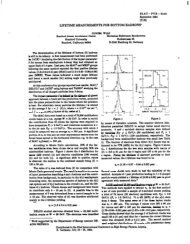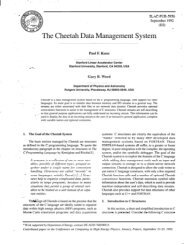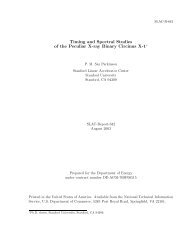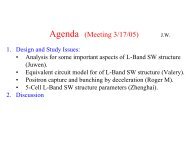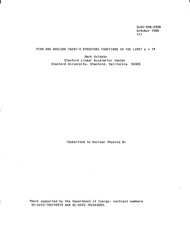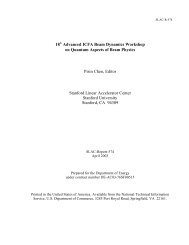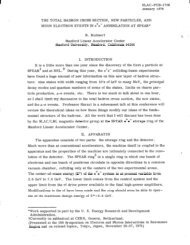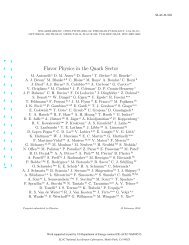slac-pub-2605 - SLAC - Stanford University
slac-pub-2605 - SLAC - Stanford University
slac-pub-2605 - SLAC - Stanford University
You also want an ePaper? Increase the reach of your titles
YUMPU automatically turns print PDFs into web optimized ePapers that Google loves.
-17-<br />
pion wavefunction. In particular, we show that the probability of finding<br />
the valence lq state in the total pion wavefunction is -0.2 to 0.25, for<br />
a broad range of confining potentials.<br />
(c) As noted above the wavefunction for the Fock states of the hadrons<br />
on the light-cone (or at infinite momentum frame) $, h) 'kLi 'xi,<br />
Z<br />
si) completely<br />
specify the quark and gluon particle content of the hadrons. The coherent<br />
aspects of the wavefunction are required for constructing the distribution<br />
amplitudes which are not only necessary for exclusive processes, but also for<br />
the multi-particle, high twist subprocesses which enter inclusive reactions<br />
and control transverse momentum smearing effects. We show that the evolution<br />
equations which specify the large Q2 behavior of the distribution amplitudes<br />
and of incoherent distribution functions G are correctly applied for Q2 ) cc?>,<br />
where is the mean value of the off-shell (light-cone/infinite momentum<br />
frame) energy in the Fock state wavefunction<br />
(<br />
Zt+rn2<br />
1<br />
Bc&'~ ----g-- .<br />
i i=l i<br />
To first approximation, is the "starting point" Qg for evolution due to<br />
perturbative effects in QCD.<br />
(2.1)<br />
Let us now discuss the constraints on meson wavefunctions imposed by<br />
their decay constants. The leptonic decays of the mesons give an important<br />
constraint on the valence Iq wavefunction at the origin. As shown in Ref.<br />
Cl,21<br />
lim $M(xi,Q) = aOx1x2 =<br />
Q-+-<br />
for R<br />
for pL<br />
where fr 2 93 MeV is the pion decay constant for r'-+u'v and f,, Z 107 MeV is<br />
(2.2)<br />
the leptonic decay constant from p" + e+e-. The analogous result holds for<br />
all zero helicity mesons. Because the Q2-+m distribution amplitude has zero



